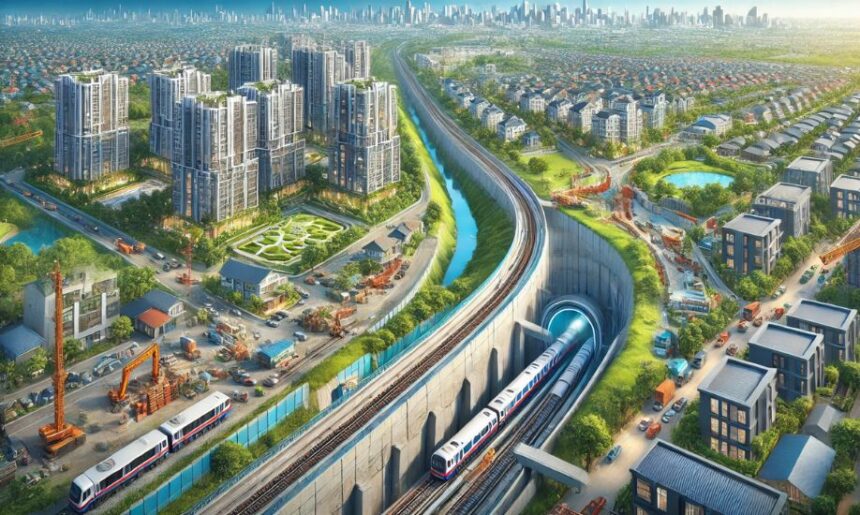The Metro Manila Subway, a landmark infrastructure project in the Philippines, is set to pass beneath Corinthian Village in Quezon City. This groundbreaking development represents a significant step toward modernizing the country’s transportation network, easing congestion, and enhancing urban mobility. With Corinthian Village as a focal point in this expansion, the project promises a profound impact on the daily lives of residents and the overall connectivity of Metro Manila.
A Game-Changing Infrastructure Project
The Metro Manila Subway is a 33-kilometer underground rapid transit system that will connect major urban centers across Metro Manila. Designed to provide a seamless and efficient mode of transportation, the subway includes 17 stations stretching from Valenzuela in the north to Bicutan in the south. A spur line will extend to Ninoy Aquino International Airport, enhancing accessibility for air travelers. By integrating Corinthian Village into the subway’s route, this project underscores the importance of connecting key residential areas with business and commercial hubs.
The Strategic Route Under Corinthian Village
Routing the Metro Manila Subway to go Under Corinthian Village is a strategic decision aimed at addressing the urban mobility challenges in this part of Quezon City. Corinthian Village, a prominent residential area, often contends with traffic congestion on major thoroughfares like EDSA and Ortigas Avenue. By providing a direct underground alternative, the subway will offer residents a faster, more reliable way to navigate the city. This alignment also ensures that the subway’s benefits extend to a broader population, particularly those who rely on efficient public transportation for their daily commutes.
Benefits of the Metro Manila Subway to go Under Corinthian Village Residents
The inclusion of Corinthian Village in the Metro Manila Subway’s route brings a host of advantages:
Improved Connectivity
Residents of Corinthian Village will enjoy unparalleled access to the subway’s extensive network, making it easier to reach business districts, schools, and leisure destinations. The reduced travel time—from hours to mere minutes—is a game-changer for commuters.
Reduction in Traffic Congestion
By shifting a significant portion of travelers from road-based transport to the subway, surface traffic in and around Corinthian Village is expected to decrease. This will not only improve air quality but also contribute to a quieter, more livable environment.
Enhanced Property Values
Proximity to a major infrastructure project like the Metro Manila Subway often leads to increased property values. Corinthian Village’s residents can anticipate a surge in real estate demand, as the area becomes more attractive to potential buyers and investors.
Eco-Friendly Transit Option
The subway’s energy-efficient design aligns with global sustainability goals. By reducing reliance on private vehicles, it contributes to a lower carbon footprint and a greener urban environment.
Addressing Construction Challenges
Despite its immense potential, the Metro Manila Subway’s construction beneath Corinthian Village presents unique challenges. Issues such as land acquisition, potential disruptions to residents, and ensuring structural integrity during tunneling require meticulous planning and execution. The Department of Transportation (DOTr) has committed to addressing these concerns through transparent communication and advanced engineering solutions.
Timeline and Current Progress
As of 2024, the Metro Manila Subway is under active development, with certain segments, including those under Corinthian Village, progressing steadily. Partial operations are expected to begin by 2029, marking a critical milestone in the project’s journey. The DOTr continues to collaborate with local and international partners to ensure timely delivery of this transformative infrastructure.
Anticipated Impact on Metro Manila
The Metro Manila Subway’s overall impact extends far beyond Corinthian Village. By providing a fast, reliable, and sustainable transportation option, the project aims to:
- Boost Economic Growth: Improved transportation will enhance productivity and enable greater economic activity across Metro Manila.
- Reduce Urban Sprawl: The subway’s connectivity can encourage more balanced urban development, reducing pressure on central business districts.
- Promote Inclusivity: Affordable and accessible public transportation will empower more people to participate in economic and social opportunities.
Corinthian Village: A Hub of Connectivity
As Corinthian Village prepares to embrace its role in the Metro Manila Subway’s network, its residents stand to benefit from a transformative shift in urban mobility. This development not only enhances local connectivity but also solidifies the village’s position as a vital node in Metro Manila’s transportation landscape.
The Future of Urban Transportation in Metro Manila
The Metro Manila Subway’s passage beneath Corinthian Village is emblematic of the broader vision for a modern, efficient, and inclusive transportation system in the Philippines. By addressing long-standing challenges and prioritizing sustainability, this project serves as a blueprint for future infrastructure initiatives. For Corinthian Village and the entire metro region, the subway is more than just a transit system; it’s a pathway to a better, more connected future.
FAQs About Metro Manila Subway to go Under Corinthian Village
Why is the Metro Manila Subway to go Under Corinthian Village?
The subway’s route under Corinthian Village is a strategic choice to enhance connectivity and provide residents with a faster, more reliable transportation option. It also addresses traffic congestion in the area.
How will the subway benefit Corinthian Village residents?
Residents will enjoy improved access to key destinations, reduced travel times, enhanced property values, and a quieter, eco-friendly environment due to decreased surface traffic.
What challenges are associated with constructing the subway under Corinthian Village?
Challenges include land acquisition, ensuring structural safety during tunneling, and minimizing disruptions to residents. The DOTr is addressing these issues with advanced engineering and transparent communication.
When will the Metro Manila Subway be operational?
Partial operations of the Metro Manila Subway are expected to begin by 2029, with steady progress being made on its construction.
What is the broader impact of the Metro Manila Subway on the region?
The subway will boost economic growth, reduce urban congestion, promote balanced development, and provide an eco-friendly transit alternative for Metro Manila.






